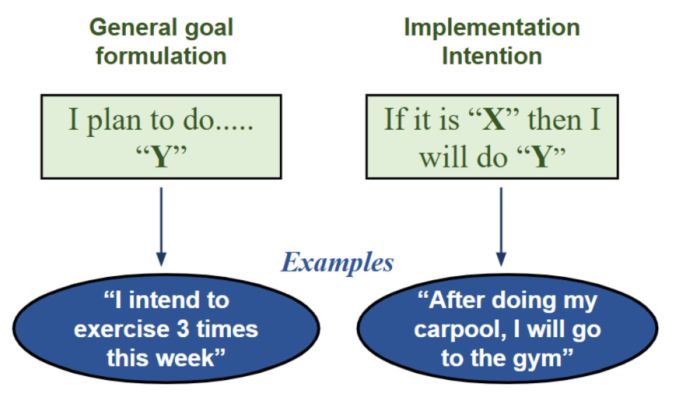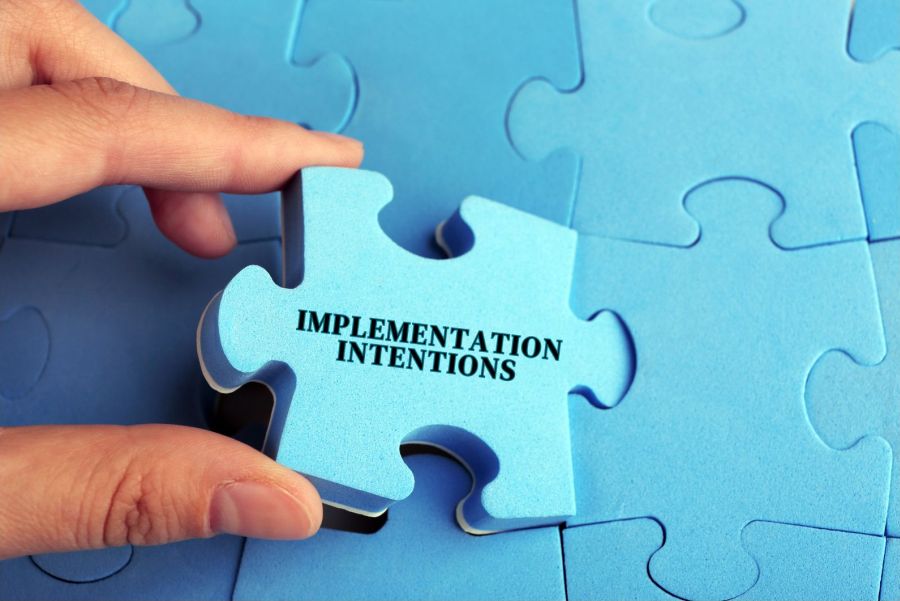Implementation Intentions Are a Powerful Tool to Create Habits
While waiting in line at a PTA meeting, I overheard a conversation that struck a chord with me:
“It’s funny,” one woman said. “I try to go to the gym after I drop the kids off at school. But if I go home first, I never seem to make it.”
“Really? So how often do you actually make it to the gym?” her friend asked.
“Oh, maybe once or twice a week. But I’d really like to go every day.”
This brief exchange highlighted a common struggle with forming healthy habits like regular exercise: following through on implementing real change. Understanding this challenge provides valuable insights into overcoming similar obstacles and building a sustainable fitness routine. How? By revealing the power of implementation intentions.
What Are Implementation Intentions?
From this conversation, two things became clear:
- The mother wanted to exercise.
- She had identified the best time—after school drop-off.
Despite her intentions, she struggled to follow through. The solution? Implementation intentions.
First introduced by psychologist Peter Gollwitzer, implementation intentions are framed as “if-then” statements:
If X arises [the cue], then I will do Y [the action].
Cues are external triggers, like a specific time, place or situation, that prompt action.
Why Implementation Intentions Work
Research shows that forming implementation intentions significantly increases the likelihood of achieving goals, whether it’s improving your fitness, adopting a healthier diet, or enhancing productivity.
A meta-analysis of 93 studies showed implementation intentions improve goal attainment in many areas, including exercise routines and other health behaviors (1).
For example, one study involved 155 women learning about the importance of breast self-examination for cancer screening (2). The women were divided into a group asked to perform an implementation intention around breast self-examination versus a group that was not. The follow-up at one month was striking. Those who were asked to create implementation intentions were significantly more likely to follow through (64%) than those who didn’t (14%).

Why Are Implementation Intentions Effective?
To understand the power of implementation intentions, it’s helpful to distinguish between new practices and habits:
New Practices: A new practice is a conscious effort to adopt a behavior. Think of it as planting a seed that requires constant care and attention to grow. In its early stages, it’s fragile and easily disrupted by distractions or life’s unpredictability.
Habits: A habit, on the other hand, is an automatic behavior—something you do without much thought. Once a practice solidifies into a habit, it becomes resistant to disruptions and operates almost effortlessly. This transition from practice to habit is the foundation of lasting success.
The Challenge of “Mental Clutter”
Here’s a familiar scenario: You resolve to exercise more. For a few weeks, you’re on track. Then life happens—work piles up, errands appear, and you’re exhausted. You start debating:
Should I go to the gym today?
Excuses pile up: “I’m too tired,” “I’m too busy,” or “I’m not in the mood.” Eventually, your new practice crumbles. This internal debate—mental clutter—derails even the best intentions. It is this mental clutter that makes new practices so fragile.
How Implementation Intentions Help
Implementation intentions tie actions to external cues, bypassing mental clutter. Instead of asking, Should I go to the gym? you follow a preset plan:
“As soon as I leave work, I will go to the gym.”
In this example, leaving work becomes an external cue that prompts your action. This approach minimizes the influence of mental clutter like debates as to whether you should exercise because you feel stressed, time pressed, or unmotivated. While you might still feel those emotions, they no longer dictate your behavior.
“Implementation intentions tie actions to external cues, bypassing mental clutter.”
Motivation and Implementation Intentions
By pre-planning your actions, you remove the need to decide what to do in the moment—a common barrier when motivation is low. The reliance on external cues rather than internal drive is what makes implementation intentions effective even when you’re not feeling motivated.
However, initial motivation is necessary to make this technique work. If your initial motivation is low, consider sharing your plan with someone else, using tools like reminders or to stay on track, or downsizing your intended goal to make it achievable.
The Mother’s Missed Opportunity
Returning to the mother at the PTA meeting: She already knew she wanted to exercise and had identified the perfect time. But she didn’t create a clear implementation intention.
Had she committed to: “As soon as I drop off my kids at school, I will go straight to the gym,” she could have avoided going home, where distractions and inertia took over.
Takeaway: Turning Intentions into Lasting Habits
We’ve all been in this woman’s shoes. We often set goals with the best of intentions, only to underestimate the resistance from our own thoughts and feelings. Forming implementation intentions aligns actions with external cues, making new practices less vulnerable to disruptions. Over time, this consistency turns fragile practices into lasting habits.
Next time you set a goal, ask yourself:
What external cue can I use to anchor my behavior?
Then commit to following that cue. By sidestepping mental battles, you’ll give your desired goals the best chance to thrive.
For more on improving your mental vitality and the Six Domains of Health, please consider subscribing to my newsletter.
References:
- Gollwitzer, P. M., & Sheeran, P. (2006). Implementation intentions and goal achievement: A meta‐analysis of effects and processes. Experimental Social Psychology, 38, 69–119
- Orbell S, Hodgkins S, Sheeran P. Implementation Intentions and the Theory of Planned Behavior. Pers Soc Psychol Bull. 1997; 23:945-954.



